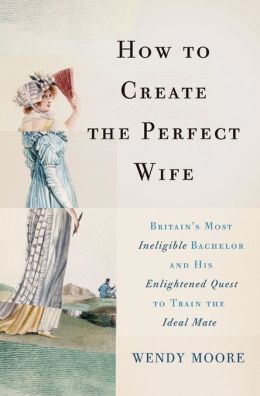How To Create the Perfect Wife: Britain's Most Ineligible Bachelor and His Enlightened Quest to Train the Ideal Mate, by Wendy Moore
Apr 30
2013

Most of the critical coverage of Wendy Moore's How To Create the Perfect Wife: Britain's Most Ineligible Bachelor and his Enlightened Quest to Train the Ideal Mate, a stranger-than-fiction account of the life of the 18th century radical Thomas Day, has focused on the biggest scandal of Day's life: his attempt to transform a 12-year-old orphan into his ideal of the perfect woman. This is totally understandable—that element of the story is pretty juicy—but Moore's book covers considerably more ground.
How To Create the Perfect Wife explores both the life of Thomas Day and those of several members of Day's social circle, a collection of well-known literary and scientific figures that included Erasmus Darwin (grandfather of Charles) and Richard Lovell Edgeworth (father of the novelist Maria Edgeworth). Day was writer and reformer whose disdain for social niceties—including table manners, hair-brushing, and routine baths—lead to a string of unsuccessful love affairs, despite the charm of his large fortune. Day was an enterprising young man, however, so when society failed to provide him with the woman of his dreams he literally set out to create her. Armed with a copy of Jean-Jacques Rousseau’s Émile (a fictional account of the ideal way to raise a child), Day acquired two preteen orphans—the equivalent of “an heir and a spare”—and attempted to transform at least one of them into a woman worthy of becoming his wife: someone simultaneously virginal and unworldly, hardy enough to serve as an unpaid servant, sufficiently well-educated to listen to his constant speeches on everything from politics to metaphysics with at least the appearance of interest, and blessed with a pair of “plump white arms”. (He was really into the plump white arms.)
Day's treatment of his young protégés was obviously deplorable, but Moore's fascinating, briskly paced book paints a broader picture. Her novel's title could quite as easily have been The Enlightenment's Biggest Hypocrite or The Man Who Was Totally Unwilling to Separate Theory From Practice. From childhood to death (he was thrown from his horse at age 41), Day served as a living example of what happens when someone is never told to stuff a sock in it. He embraced a series of Grand Ideas and doggedly carried them out, even as his fellow enthusiasts were forced to adjust their ideas according to the dictates of reality. Moore investigates the unique combination of social conditions, economic factors, and personal peculiarities that created Day—an intelligent, dynamic, passionate figure, whose pomposity and conceit was allowed to develop (apart from a few smackdowns delivered by unimpressed potential wives) entirely unchecked, resulting in the kind of untrammeled ego that would allow him to play God with the lives of two unprotected and innocent girls.
How To Create the Perfect Wife explores both the life of Thomas Day and those of several members of Day's social circle, a collection of well-known literary and scientific figures that included Erasmus Darwin (grandfather of Charles) and Richard Lovell Edgeworth (father of the novelist Maria Edgeworth). Day was writer and reformer whose disdain for social niceties—including table manners, hair-brushing, and routine baths—lead to a string of unsuccessful love affairs, despite the charm of his large fortune. Day was an enterprising young man, however, so when society failed to provide him with the woman of his dreams he literally set out to create her. Armed with a copy of Jean-Jacques Rousseau’s Émile (a fictional account of the ideal way to raise a child), Day acquired two preteen orphans—the equivalent of “an heir and a spare”—and attempted to transform at least one of them into a woman worthy of becoming his wife: someone simultaneously virginal and unworldly, hardy enough to serve as an unpaid servant, sufficiently well-educated to listen to his constant speeches on everything from politics to metaphysics with at least the appearance of interest, and blessed with a pair of “plump white arms”. (He was really into the plump white arms.)
Day's treatment of his young protégés was obviously deplorable, but Moore's fascinating, briskly paced book paints a broader picture. Her novel's title could quite as easily have been The Enlightenment's Biggest Hypocrite or The Man Who Was Totally Unwilling to Separate Theory From Practice. From childhood to death (he was thrown from his horse at age 41), Day served as a living example of what happens when someone is never told to stuff a sock in it. He embraced a series of Grand Ideas and doggedly carried them out, even as his fellow enthusiasts were forced to adjust their ideas according to the dictates of reality. Moore investigates the unique combination of social conditions, economic factors, and personal peculiarities that created Day—an intelligent, dynamic, passionate figure, whose pomposity and conceit was allowed to develop (apart from a few smackdowns delivered by unimpressed potential wives) entirely unchecked, resulting in the kind of untrammeled ego that would allow him to play God with the lives of two unprotected and innocent girls.
Posted by: Julianka
No new comments are allowed on this post.
Comments
No comments yet. Be the first!